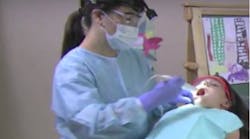One of the biggest successes in teledentistry, the Pacific Center for Special Care, recently received a $400,000 grant to expand its program in California and continue conversations with other states interested in starting or growing their programs.
The grant is from the North Bay Regional Center (NBRC) and will support the use of the Pacific Center's "Virtual Dental Home" system throughout Sonoma, Napa, and Solano counties. It will help provide diagnostic services and prevention and early intervention care for people with complex developmental, medical, and physical conditions.
According to its website, “The Pacific Center for Special Care is an organization within the Arthur A. Dugoni School of Dentistry (in San Francisco) committed to improving the oral health of underserved people on the local, state, and federal level."
It continues, "The Center has created best-practice models of, and advocates for, improved access to dental care for anyone who faces challenges receiving oral health services through the traditional oral health care system. This includes groups and individuals who have difficulty maintaining good oral health or accessing oral health services because of medical, physical, social, economic, and geographic conditions.”
According to Dr. Paul Glassman, founder and director of the Pacific Center for Special Care, the innovative model for delivering dental care using teledentistry technology, Virtual Dental Home connects a dentist in the dental office with licensed allied dental professionals working with underserved populations. People receive preventive and simple therapeutic services in community settings. The system brings much-needed services to individuals who might otherwise receive no care.
In a six-year pilot program, the Pacific Center has implemented the Virtual Dental Home system in 50 California Head Start preschools, elementary schools, community centers, residential care facilities for people with disabilities, senior centers, and nursing homes. The Pacific Center team is now working with colleagues in Oregon, Hawaii, and Colorado to replicate the system.
"Our hope is to significantly reduce the number of people with developmental disabilities in the North Bay who need to have dental procedures performed using sedation and general anesthesia," said Dr. Glassman. "Emphasizing preventive procedures in residential and community settings will improve the health of the individuals served in this system, lower financial and other costs, and support people living in community settings."
RELATED ARTICLES:Teledental hygiene: No longer a futuristic theory
Will teledental catch up? The pulse for dentistry's contribution often appears weak
DentistryIQ recently asked Dr. Glassman to further discuss this teledentistry concept and its success. He took the time to answer a few of our questions.
DentistryIQ: Can you provide some background on why and how the Virtual Dental Home idea and program came about?
Dr. Paul Glassman: The VDH was an evolution from 20 years of work I have been doing on improving oral health of non-served or underserved groups. It brings oral health services to locations and organization that serve these populations by providing educational, social, and general health services. About a decade ago the technology got to the point where we were able to incorporate it and develop the full Virtual Dental Home system.
DIQ: What would you consider the biggest successes of the program?
Dr. Glassman: As indicated in our recent report, we were able to demonstrate that we could:
• Reach people who traditionally did not get dental care until they had advanced disease
• Successfully integrate oral health services into educational, social, and general health environments
• Apply proven preventive and early intervention techniques
• Raise awareness about oral health issues in order to support people in adopting oral healthy lifestyles
• Include dentists in these community sites using the telehealth technology
• Create a full system of care for people who traditionally get no care until they have advanced disease.
DIQ: Can you give an example of a success story?
Dr. Glassman: A seven-year-old boy in San Diego came to see the dental hygienist working in his school. His teeth were covered with orange, caked-on material. She cleaned his teeth and encouraged him brush his teeth regularly. He told her he did not have a toothbrush. He said he had previously had one but it was stolen by his siblings. Her “treatment” for him was to give him a toothbrush whenever she saw him. This is a child who now has healthy teeth, but would never have made it into a dental office.
DIQ: Any expansion plans beyond Oregon, Hawaii, and Colorado?
Dr. Glassman: We are having discussions with and interest from many other states. I just received two requests yesterday and have multiple other conversations in progress. I have no doubt that this system will be in place across the country in the coming decades.
DIQ: Why would you encourage other states to consider teledentistry programs?
Dr. Glassman: It is clear that the current dental care system in the U.S. reaches only a minority of the population. Many groups, including the Institute of Medicine, have concluded that to do better we must find ways to “bring care to where people are.” Systems that employ teledentistry and can create telehealth-connected teams and Virtual Dental Homes are a very viable way to do this.
DIQ: Why are you proud of this program?
Dr. Glassman: It is clear that using telehealth-connected teams and Virtual Dental Homes is an effective way to reach non-served or underserved groups, emphasize prevention and early intervention procedures, integrate oral health into educational, social, and general health systems, and minimize the cost and consequences of neglect.
To learn more about the Virtual Dental Home and the Pacific Center for Special Care's other innovative approaches to improving the health care needs of underserved people, visit dental.pacific.edu/departments-and-groups/pacific-center-for-special-care. To learn more about the services and programs of the NBRC, visit nbrc.net.






